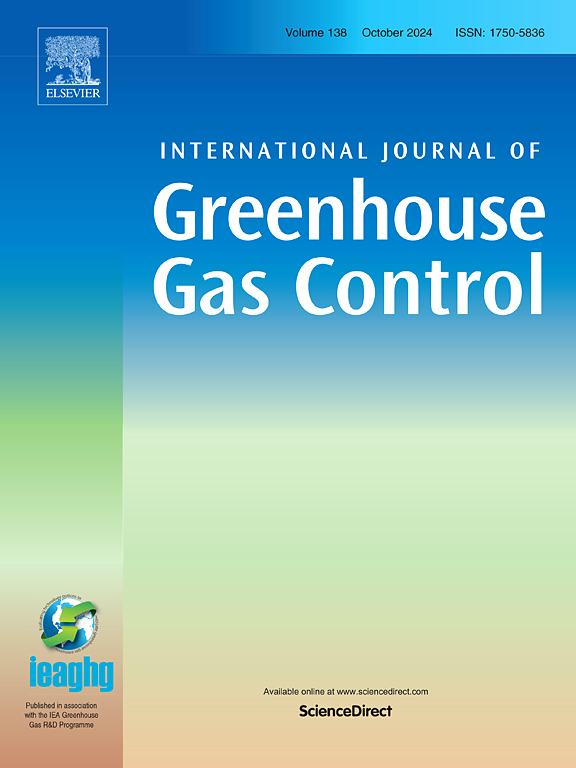深部咸水层大规模注入二氧化碳地质固碳井筒完整性机理评价
IF 5.2
3区 工程技术
Q2 ENERGY & FUELS
International Journal of Greenhouse Gas Control
Pub Date : 2025-06-20
DOI:10.1016/j.ijggc.2025.104425
引用次数: 0
摘要
本文通过模拟三层套管-水泥鞘层-岩石地层(C/CS/RF)系统的相关应力分布演变,研究了深层盐水含水层大量注入二氧化碳(CO2)过程中的井筒完整性。采用了一种新颖的方案,结合了总共11种(“10+1″”)失效机制,用于离散地评估C/CS/RF系统的每一层。沿着C/CS和CS/RF界面的法向有效应力的大小提供了一组校准参数,通过估计水泥固化过程中产生的“自由应变”来模拟中间CS层的应力分布,同时C/CS/RF系统的完整性是在封闭(有界系统)和开放(无界系统)含水层中进行30年的大量co2注入评估的。据预测,在封闭含水层配置的中cs层中,盘状破坏以及径向和剪切开裂趋势为二氧化碳泄漏回大气提供了潜在途径。上述三种破坏趋势在开放含水层构型中也存在,尽管程度较小。生成的应力分布表明,沿C/CS界面无内剥离趋势,在CS/RF界面处接近外剥离极限,但未超过。此外,CS/RF界面没有预测到拉伸失效(通过纵向或横向裂缝起裂),也没有预测到套管失效(与压缩/拉伸和崩溃/爆裂应力载荷有关)。这两种情况(封闭或开放含水层配置)都不会引发二氧化碳注入井附近已有断层(pef)的地震活动。最后,通过分析和数值方法对CO2/盐水驱替进行了概述,作为在不影响井筒完整性的情况下提高储气效率的替代方法。本文章由计算机程序翻译,如有差异,请以英文原文为准。
Mechanistic assessments of wellbore integrity for geologic carbon sequestration in deep saline aquifers via bulk-CO2 injection
This paper examines wellbore integrity during bulk injection of carbon dioxide (CO2) in deep saline aquifers, by modeling the associated stress-distribution evolutions within the three-layer casing-cement sheath-rock formation (C/CS/RF) system. A novel scheme, incorporating a total of eleven (“″) failure mechanisms is used to assess each layer of the C/CS/RF system, discretely.
The magnitude of the normal-effective stresses along the C/CS and CS/RF interfaces provide a set of calibration parameters to model the stress distributions within the intermediate-CS layer via estimating “free strains” created during the cement-curing process, while the integrity of the C/CS/RF system is assessed over a 30-year period of bulk-CO2 injection in a closed (bounded system) and an open (unbounded system) aquifer. Disking failures, along with radial and shear-cracking tendencies, predicted within the intermediate-CS layer in closed-aquifer configurations, provide potential pathways for CO2 leakages back into the atmosphere. The three aforementioned failure tendencies remain in open-aquifer configurations also, albeit to a smaller degree.
The generated stress distributions indicate no-inner debonding tendency along the C/CS interface, with the outer-debonding limit approached at the CS/RF interface, yet not exceeded. Furthermore, no tensile failures (via longitudinal or transverse-fracture initiation) are predicted from the CS/RF interface, nor any casing failures (related to compressive/tensile and collapse/burst stress loads). Neither of these scenarios (closed or open-aquifer configurations) is expected to trigger seismic activity along pre-existing faults (PEFs) in the CO2-injection well’s vicinity. Finally, CO2/brine displacement is overviewed using analytical and numerical means, as an alternative approach for potentially increasing storage efficiencies without wellbore-integrity compromises.
求助全文
通过发布文献求助,成功后即可免费获取论文全文。
去求助
来源期刊
CiteScore
9.20
自引率
10.30%
发文量
199
审稿时长
4.8 months
期刊介绍:
The International Journal of Greenhouse Gas Control is a peer reviewed journal focusing on scientific and engineering developments in greenhouse gas control through capture and storage at large stationary emitters in the power sector and in other major resource, manufacturing and production industries. The Journal covers all greenhouse gas emissions within the power and industrial sectors, and comprises both technical and non-technical related literature in one volume. Original research, review and comments papers are included.

 求助内容:
求助内容: 应助结果提醒方式:
应助结果提醒方式:


